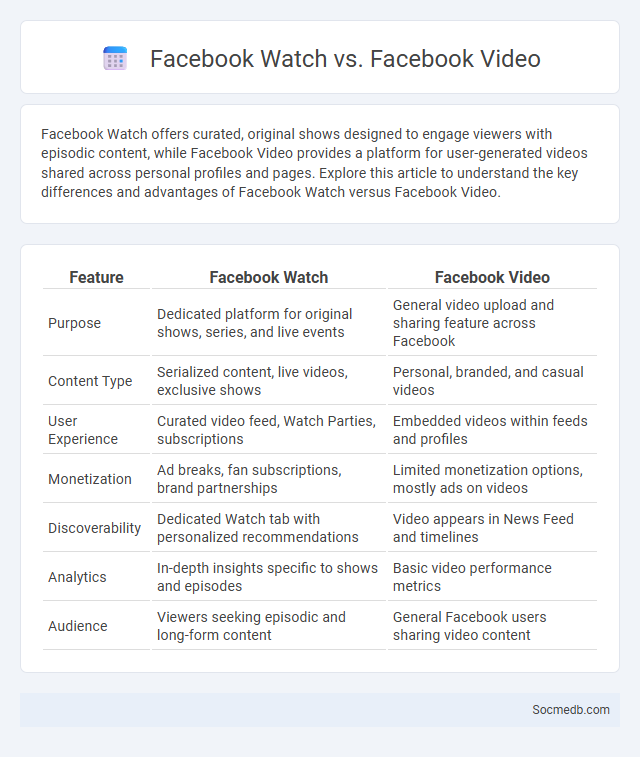
Photo illustration: Facebook Watch vs Facebook Video
Facebook Watch offers curated, original shows designed to engage viewers with episodic content, while Facebook Video provides a platform for user-generated videos shared across personal profiles and pages. Explore this article to understand the key differences and advantages of Facebook Watch versus Facebook Video.
Table of Comparison
| Feature | Facebook Watch | Facebook Video |
|---|---|---|
| Purpose | Dedicated platform for original shows, series, and live events | General video upload and sharing feature across Facebook |
| Content Type | Serialized content, live videos, exclusive shows | Personal, branded, and casual videos |
| User Experience | Curated video feed, Watch Parties, subscriptions | Embedded videos within feeds and profiles |
| Monetization | Ad breaks, fan subscriptions, brand partnerships | Limited monetization options, mostly ads on videos |
| Discoverability | Dedicated Watch tab with personalized recommendations | Video appears in News Feed and timelines |
| Analytics | In-depth insights specific to shows and episodes | Basic video performance metrics |
| Audience | Viewers seeking episodic and long-form content | General Facebook users sharing video content |
Introduction: Understanding Facebook’s Video Platforms
Facebook's video platforms include features like Facebook Watch, Live, and in-feed videos designed to enhance user engagement through dynamic content. These platforms utilize advanced algorithms to personalize video recommendations based on your interests and viewing history. Leveraging Facebook's robust video tools can significantly boost your audience reach and interaction rates.
What is Facebook Watch?
Facebook Watch is a video-on-demand service integrated within the Facebook platform, designed to offer personalized video content including shows, live events, and user-generated clips. It leverages Facebook's social graph to recommend videos based on users' interests and interactions, enhancing engagement through comments, shares, and real-time reactions. With features like Watch Parties and original programming, Facebook Watch aims to create a communal viewing experience that competes with other streaming services.
What is Facebook Video?
Facebook Video is a feature on the Facebook platform that allows users to upload, share, and watch videos within the social network. Your videos can reach a broad audience, leveraging Facebook's extensive user base and advanced algorithms designed to increase viewer engagement. This tool supports various video formats and offers interactive options such as live streaming, comments, and reactions to enhance social connections.
Facebook Watch vs Facebook Video: Key Differences
Facebook Watch offers a dedicated platform for original shows, live events, and interactive videos, enhancing viewer engagement through exclusive content and community features. Facebook Video encompasses all video uploads on the main Facebook feed, including personal clips, ads, and shared videos, providing broader content diversity but less curation. Understanding these distinctions helps you optimize your video strategy for targeted audience interaction or general reach on Facebook.
Features of Facebook Watch
Facebook Watch offers personalized video recommendations and a robust library of original shows, live events, and user-generated content designed to engage viewers. Your viewing experience is enhanced by interactive features such as real-time reactions, comments, and watch parties that allow seamless social interaction. The platform's integration with Facebook's social graph enables tailored content discovery based on your interests and social connections.
Features of Facebook Video
Facebook Video offers a variety of features designed to enhance user engagement and content visibility, including autoplay in news feeds, live streaming capabilities, and 360-degree video support. You can leverage Facebook's video insights to track viewer demographics, watch time, and engagement metrics, optimizing your content strategy effectively. The platform also supports video subtitles, embedding options, and interactive elements such as polls and call-to-action buttons for increased viewer interaction.
Content Availability and Discoverability
Social media platforms prioritize content availability by ensuring fast and reliable access to posts through advanced caching and distributed servers. Discoverability is enhanced using algorithm-driven feeds and personalized recommendations that analyze user behavior and preferences. Metadata tagging and search engine integration further improve content visibility, enabling users to find relevant information quickly and efficiently.
Monetization and Opportunities for Creators
Social media platforms offer vast monetization opportunities for creators through features like sponsored content, affiliate marketing, and direct fan support via subscriptions or donations. You can leverage algorithms that boost engagement and targeted advertising to maximize your earnings while expanding your audience reach. Understanding these dynamics helps creators transform their content into steady revenue streams and long-term career growth.
User Experience and Accessibility
Optimizing social media platforms for user experience involves intuitive navigation, fast loading times, and personalized content that keeps Your engagement high. Accessibility features such as screen reader compatibility, keyboard navigation, and adjustable font sizes ensure inclusivity for users with disabilities. Prioritizing these elements enhances satisfaction and broadens the platform's reach across diverse audiences.
Choosing the Best Platform for Your Content
Selecting the best social media platform for your content depends on understanding your target audience's demographics and engagement behavior across channels like Instagram, TikTok, LinkedIn, and Facebook. Content creators should analyze platform-specific algorithms, content formats, and trending topics to maximize reach and interaction. Tailoring content to each platform's unique features boosts visibility, fostering stronger audience connections and brand growth.
 socmedb.com
socmedb.com